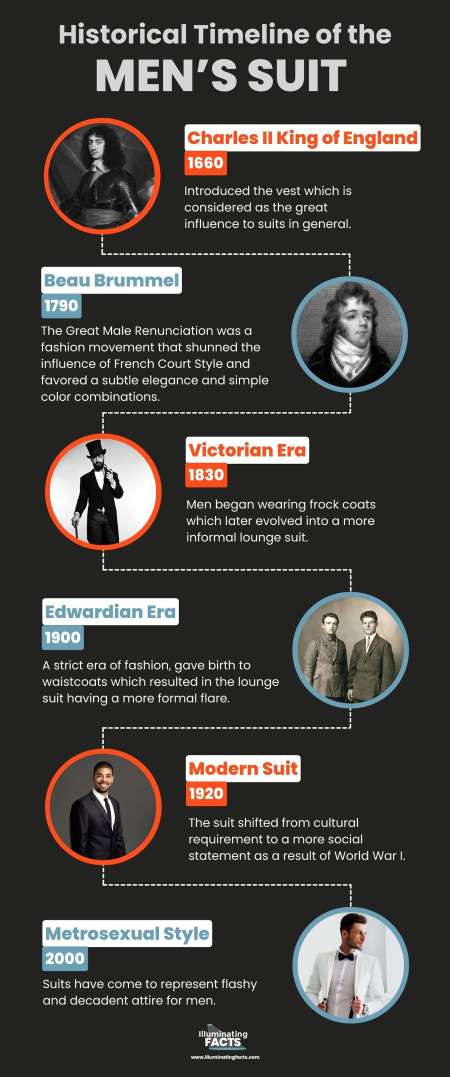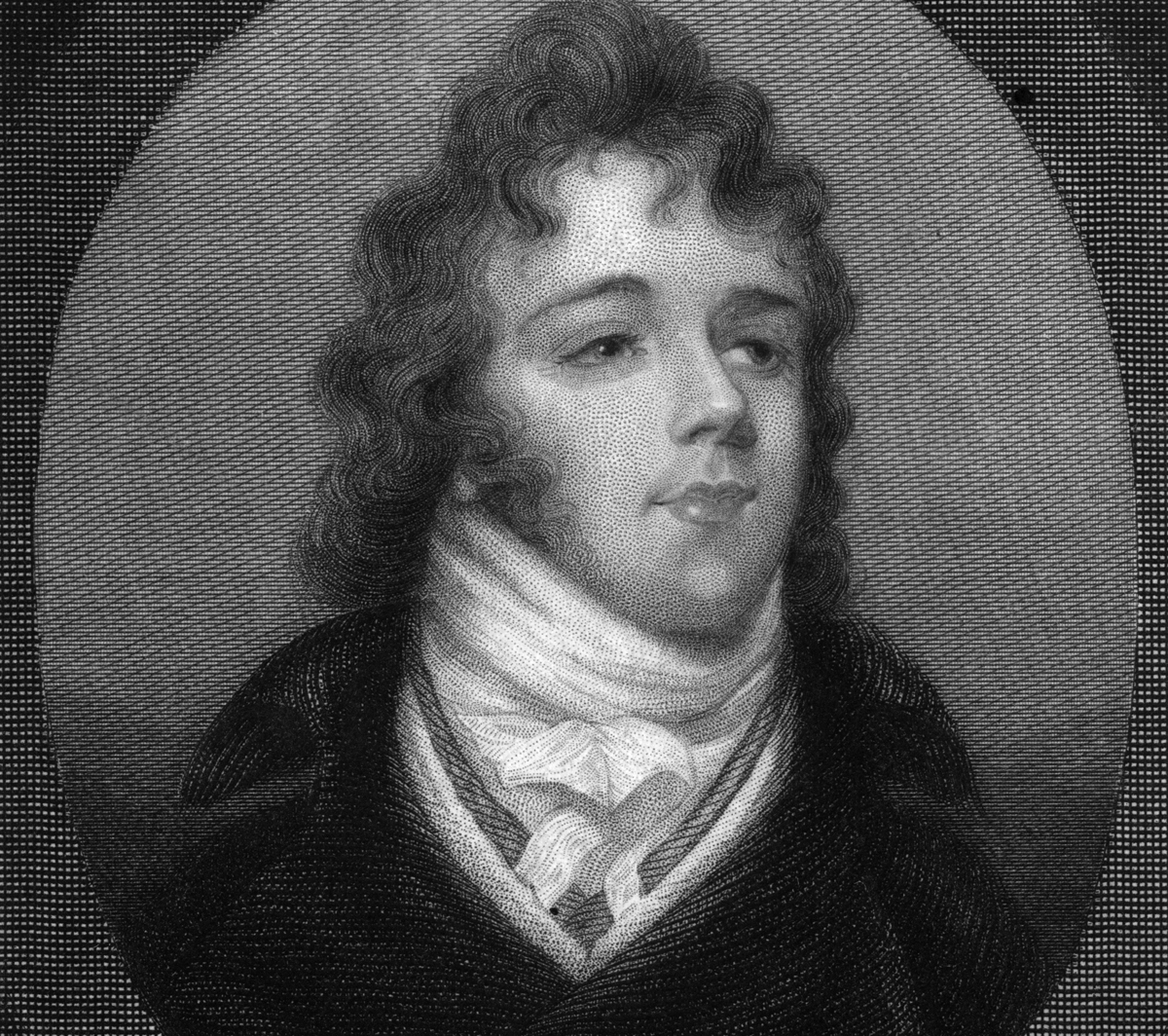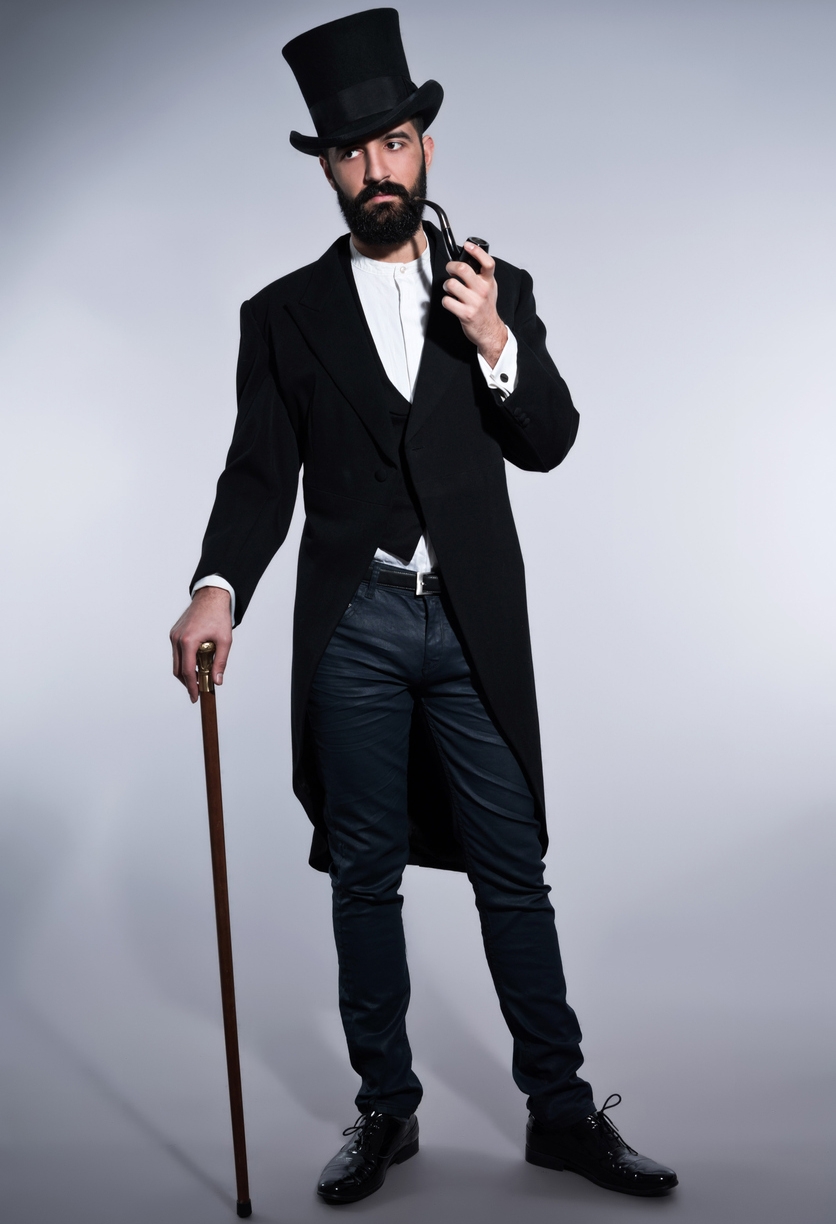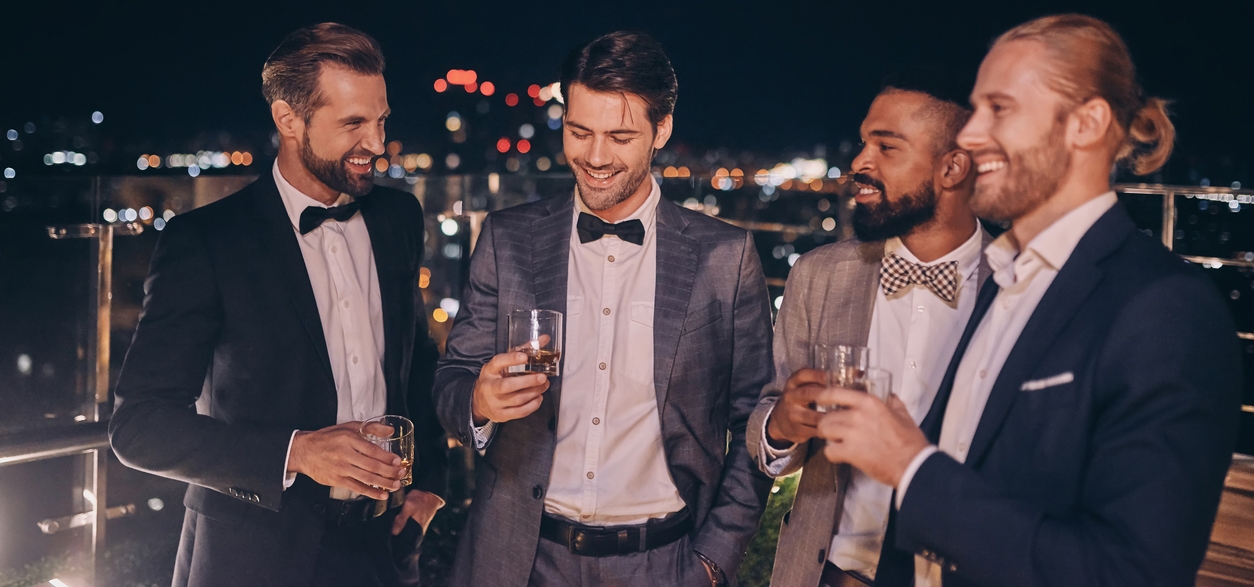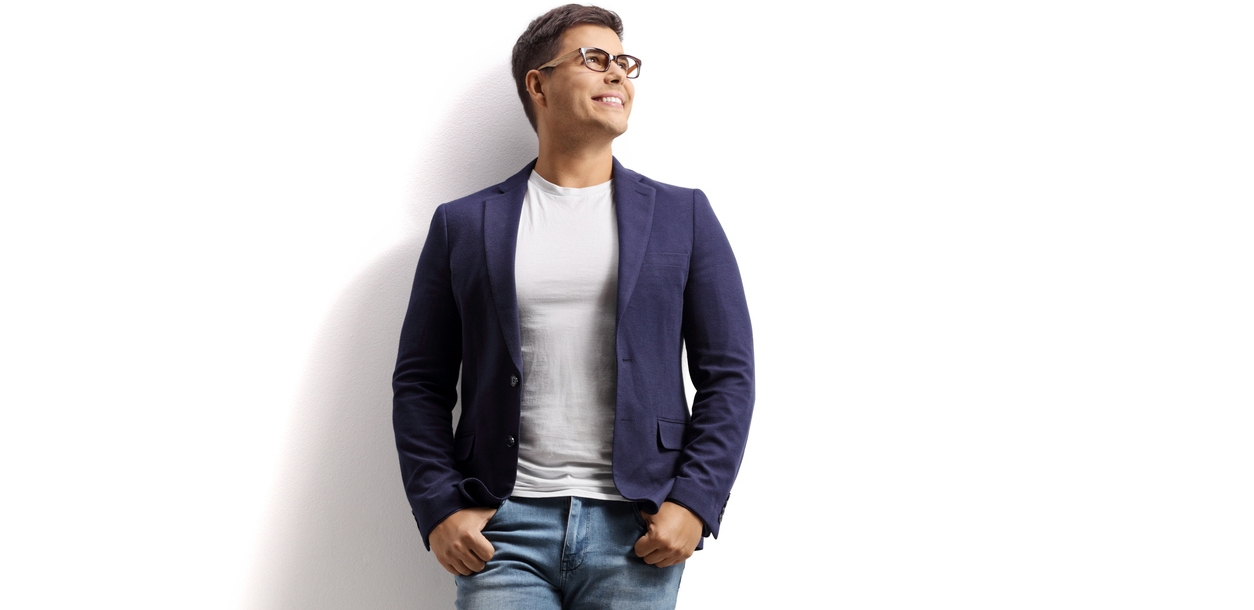Introduction
The modern man’s go-to formal attire is a suit. It is frequently the most expensive item in a man’s wardrobe and the one chosen with the most care. It is the standard outfit for significant life events like weddings or crucial business meetings. When a man wants to look his best, he is most likely to wear this outfit. Additionally, it is a piece of clothing with a long and fascinating history.
Suits have evolved with time and have gone through different style revamps since they were introduced during the 1600s. From the simple vest, it has undergone thorough transformations. Since its inception, suits have been a symbol of elegance among men. Men have traditionally worn formal suits to different special occasions and important events or formal gatherings over the years. But time has changed how the fashion world views suits from what is considered proper to wear. Since the early 1900s, there have been considerable changes in men’s fashion. The sleek, sophisticated style of Today is substantially different from the bold colors and numerous patterns of the 1970s. Today the standards of wearing suits have become accessible and contemporary. [1]
The truth is that the expensive, frequently embroidered, and jeweled garb of western nobility throughout the Industrial Revolution gave way to Today’s more functional and comfortable clothing.
What is a Suit?
Despite appearing to have originated in England, the suit and tie have become the norm for formal attire worldwide. Men’s dashing look would not be complete without donning an explicitly handsome suit. Since its inception, men’s formal wear, such as the suit, has undergone different changes influenced by the rapid movement of technology and the fashion world.
The pinnacle of menswear is still a perfectly tailored, accessorized, and designed suit. The term suit originated from the French word suivre, which means “to follow”; therefore, the coat and the pants are well coordinated or the other way around. [1]
Consequently, a suit is made up of a matching-fabric jacket and pants. Not only is the color of the clothing same, but so is the fabric’s makeup. Suits, the most significant part of men’s fashion with a long history, serve as a handy measure for an ideal masculine style. Most aristocratic elites have worn suits throughout history in all societies. Even the most dominant cavemen possessed the most incredible pair of formal suits. The men’s suit, Today’s go-to attire that seems simple and obvious, is the culmination of this evolution.
Historical Timeline of the Men’s Suit
| Era | Year | Notable Events |
| Charles II King of England | 1660 | Introduced the vest considered which is considered as the great influence to suits in general. |
| Beau Brummel | 1790 | The Great Male Renunciation was a fashion movement that shunned the influence of French Court Style and favored a subtle elegance and simple color combinations. |
| Victorian Era | 1830 | Men began wearing frock coats which later evolved into a more informal lounge suit. |
| Edwardian Era | 1900 | A strict era of fashion, gave birth to waistcoats which resulted in the lounge suit having a more formal flare. |
| Modern Suit | 1920 | The suit shifted from cultural requirement to a more social statement as a result of World War I. |
| Metrosexual Style | 2000 | Suits have come to represent flashy and decadent attire for men. |
The men’s suit has been subject to different artistic fashion alterations through time; just like any other interesting piece of fashion, the men’s suit has a long history of revisions and styling. Designers have taken a keen interest in creating men’s suits that would reflect men’s vigor and masculinity throughout history.
Charles II King of England (1660’s)
Although the first inventor of a suit is unknown in the records of the history book, most fashion enthusiasts credited Charles II, the King of England as the prime mover of a suit. Charles II was well-known for his extravagant and flamboyant fashion in the 1660s. One of his remarkable contributions to the history of suits is the introduction of the vest, which he did to deviate from the French style and support the English wool industry. [4]
Beau Brummell The Trendsetter (1790’s)
The beginning of men’s suit was said to date to the times of George Bryan “Beau” Brummel, a menswear trendsetter who was an English dandy and gentleman of leisure. The opinions of Brummell on menswear have shaped fashion, and his sense of style has a significant impact on the current men’s suit style. In addition to being credited with popularizing much traditional menswear, his enthralling life served as a rich source of inspiration for countless short stories, books, movies, and television shows. [2]
One of the most remarkable contributions of Brummel to the fashion industry was the “Great Male Renunciation” movement. This fashion revolution shuns the ostentatious influence of French Court style, including accessories like decorative silks, knee breeches with stockings, elaborate wigs, perfume, and white hair powder. Instead of the tacky fancy clothes of the Georgian gentleman, he favored a subtle elegance and a small color pallet. He was well-known for his intricately folded necktie and blue jacket, which was made of bath coating. It was Brummell’s opinion that was important for a long time. He has the power to make someone fashionable or unfashionable, with his excellent fashion influence among the ton during his time. [3]
The Victorian Era (1830’s to 1901)
Men began donning frock coats at the beginning of the Victorian era; these were black coats that looked like modern overcoats. It seemed like an overcoat because of how long it was—down to the knees. It was the most popular option for formal daywear then; however, it is now generally reserved for royal or high-class weddings. In the US and other countries outside of England, people who genuinely enjoy classic men’s clothes or have a particular rank in society are usually the only ones who choose to wear a morning coat to their wedding. [1]
Moreover, the lounge suit was first created in Scotland between the 1860s and 1850s. It was designed to be a casual outdoor outfit and thicker cloth. Today, yet throughout the Victorian era, it was considered a comfy outfit for lounging around. It seems that frock coats and morning coats were worn with somewhat contrasting trousers, the matching of the pants and the trousers made it seem less formal, and without the tails, the coat was significantly shorter and cut more sack-like without obvious front darts. [4]
The Edwardian Era (1900’s)
In contrast with the previous notion of the lounge suit as a more relaxed, informal way to dress, typically saved for outdoor activities, the lounge suit did acquire a little more formal air throughout the Edwardian era. Waistcoats provided an additional layer of warmth and style, lighter fabrics were utilized in the garment’s creation, and the trousers were coordinated with the jacket. Solid and woven textiles colored in dark hues were used to make men’s suits. During this time, high shirt collars and narrow lapels on suit coats were in style. The three-piece suit was more widely worn than the two-piece suit. [4]
This specific era was known as a highly tough time in fashion. The time of day determined what a man should workwear. Because of the rigorous styles of the day, a smartly dressed man needed a morning suit, a lounge suit, and a dinner suit. Men wore head accessories to match their morning coats or dinner coats, including top hats, bowler hats, and boater hats. Bow ties, neckties, and ascots were popular neck accessories during this time.
Modern Suits (1920’s to 1980s)
The suit was just one of the cultural and social elements that shifted because of World War I. Within a short period, everyone was donning a modern suit, from an ordinary man to a man with a significant societal role. As countries began to rise from the depression brought about by war, the world was ruled by capitalism, business, and the free market, and workers were required to wear uniforms, which made suits a convenient uniform. It brought structure and formality to a working environment still figuring itself out.
Men’s formal clothing didn’t undergo a substantial transformation until the 1950s because the 1930s and 1940s were a time of war and hardship. The suits from the 1950s had longer coats and cuffed pants, making them highly sophisticated and attractive. These suits were available in muted hues like grey, black, and blue. They temporarily left the vivid hues of the 1920s behind. [4]
The Metrosexual Style (2000 to Present)
Men have become increasingly sensitive to their looks over time. Sales of skincare items for men have increased, and suits have come to represent men’s flashy and hedonistic aspects. Velvets and embossed embroidery from opulent textiles accentuate each person’s unique traits and personality. Suits started to appear frequently at sporting events, illustrating the mindset change toward self-care. Traditionally, comfy loungewear was worn while playing sports like football and poker. Similarly, when health and clean eating trends changed, so did the fashion, and stylish looks began to appear at poker tables and on the sidelines of football games. [5]
Types of Men’s Suits
The most versatile and widely accepted piece of apparel for fashion men is unquestionably the suit. A man wearing a stylishly attractive suit will never look out of place. The suit has been the foundation of man’s style since the 1600s, worn with confidence and a little fashion acumen. There are many different styles and suits available right now, so you can pick one based on the situation. However, one should consider their style before purchasing a suit because not everyone can wear every kind of suit. Here are the different types of suits available on the market that are suitable for every occasion. [7] [9] [10]
General Types of Suits
- One Piece Suit – This ensemble, which consists of a suit, jacket, and pants, is appropriate for weddings, job interviews, and business functions. Most people choose custom-made one-piece suits since they are more comfortable and allow you to select your fabric.
- Two-Piece Suit – The two-piece suit is the most widely worn style of men’s suits worldwide, which creates a well-clothed, sophisticated masculine look. A man can dress in a two-piece suit in various ways to fit his references or depending on the occasion.
- Three Piece Suit – A three-piece men’s suits are ideal for elegant gentlemen since it gives a whole appearance in an innovative and traditional aspect. It is basically made up of a suit jacket, a waistcoat, and pants.
- Waistcoat – Waistcoats are one of the most current outfits for gentlemen. It is appropriate for both social and professional settings. It can be worn alone or tucked under a stylish suit jacket with trousers and a button-up shirt.
- Tuxedo – Tuxedos are fashioned from pure, high-quality materials like velvet, cotton, silk, and linen. When worn, a stitched tuxedo has a tailored appearance and fits your body well. They are available in various hues, cuts, and styles.
Cuts and Style
- Italian Suit – The Italian suit is one of the most fashionable and popular types of suits. This is the finest choice if you believe a short, tightly fitting suit will complement your personality. These suits’ buttons are higher if you compare them to American or British suits. These have cushioned lapels and shoulder notches that go well with your individuality.
- American Suit – The American suit, also known as a sack suit, is an enduringly common and favored type of business attire. Both a padded shoulder and a single vent are absent. This suit’s flap pocket is a distinctive feature that can set it apart from other suits.
- British Suit – The British cut has the most historical roots because it was inspired by English military garb. It has clean, precisely carved lines and a very structured silhouette. The British Cut has several characteristics, such as heavier fabrics and clearly defined shoulders, chests, and waistlines, which gives off a decidedly manly appearance. Typical British suit jackets will have multiple vents at the back, which is associated with the horse-riding background styles. Another element that distinguishes this appearance is the hacking pockets.
- Slim Fit Suit – A man’s must-suit is a slim-cut blue suit with two buttons and a notched lapel. It will cover the needs for weddings, job interviews, and different kinds of appearances. The slim-fit suit looks great on any body shape. One will look fantastic with this suit without being too slender and drawing attention to all its wearer’s lumps and bumps.
- Single- and Double-Breasted Suit – Single-breasted suits have one, two, or three buttons straight down the front seam. They frequently, but not always, have a notch lapel. On the other hand, a double-breasted suit has overlapping front flaps and two parallel button lines. There is often one to four button rows on double-breasted suit jackets, but only one or two are utilized. In addition, a button known as the anchor or jigger can be found within the coat. Furthermore, the right lapel typically folds over the left lapel. The modern double-breasted suit features higher armholes and shorter sleeves. It gives off a cleaner, crisper appearance. It also fits leaner, giving it a more contemporary, understated look. The oversized peak lapels on these suits also offer the appearance of having a bigger chest while drawing attention to an optical illusion that gives height.
- Notch/ Shawl/ Peak Lapel Another excellent choice Although it tends toward formality, this men’s suit style is a good choice for any occasion. One of the most typical is the notch lapel, typically seen on single-breasted suit coats. Only a Tuxedo Suit has a shawl lapel, which lacks a peak and a notch in favor of a rounded edge. The peak lapel is a chic alternative to the notch lapel, with the top lapel edges angling sharply inward beneath the collar. It usually appears in double-breasted suits, making it a constant presence at formal events.
- Patch/ Flap and Jetted Pocket Another excellent choice Patch pockets can downgrade a suit, so they’re better suited for less formal weddings, a day at the races, or a relaxed weekend event. They are also simple to wear without a tie. The flap pocket is more adaptable than the patch pocket because it can be dressed up or down. This suit jacket design—possibly the most popular—can go from the boardroom to the boardwalk for a romantic date. The most typical suit you’ll find on black tie occasions is a jetted pocket, which provides a suit jacket with a more formal appearance. Unlike the patch pocket, which hangs on the outside, this style of pocket is cut inside the jacket’s lining.
- Navy Suit – When collecting a formal clothing ensemble, blue serves as one of the most crucial hues to possess. You can wear it with various shirts and ties, making it acceptable for any occasion.
- Dark Grey Suit – The second most crucial hue to own is dark grey, like navy suits; one can wear it frequently with the proper shirt and tie ensemble.
- Patterned and Tweed Suit – Another excellent choice is a suit with a pattern like plaid or stripes because it will stand out slightly more than a suit in a plain hue. In comparison, tweed suits are the ideal winter clothing because they are thick, warm, and long-lasting, with a slightly fuzzy texture. Due to their complementary character and ability to bring charm to the image of their wearer, these look the best with tweed suit pants and flat front pants.
| Types of Suits | Specific Style | Defining Features |
| General Type of Suits | One Piece | -consists of a suit, jacket, and pants
– used for formal events |
| Two Piece | – consists of a formal suit jacket and matching suit pants.
– most widely worn style of men’s suits worldwide. |
|
| Three Piece Suit | – made up of a suit jacket, a waistcoat, and pants
– it has both an innovative and traditional aspect. |
|
| Waistcoat | – one of the most current outfits for gentlemen
– can be worn alone or tucked under a stylish suit jacket with trousers and a button-up shirt. |
|
| Tuxedo | – made from pure, high-quality materials like velvet, cotton, silk, and linen. | |
| Cut and Styles | Italian Cut | -short, tightly fitting suit
-suits’ buttons are higher compared to American or British suits. -have cushioned lapels and shoulder notches |
| American Cut | – a sack suit,
– have a padded shoulder and a single vent are absent. – suit’s flap pocket is a distinctive feature. |
|
| British Cut | -heavier fabrics and clearly defined shoulders, chests, and waistlines
– have multiple vents at the back, associated with the horse-riding background styles. -Another element that distinguishes this appearance is the hacking pockets. |
|
| Slim Fit Suit | -a blue suit with two buttons and a notched lapel. | |
| Breast Style | Single Breasted Suit | have one, two, or three buttons straight down the front seam.
frequently, but not always, have a notch lapel. |
| Double Breasted Suit | has overlapping front flaps and two parallel button lines.
often has one to four button rows on double-breasted suit jackets, but only one or two are utilized. a button known as the anchor or jigger can be found within the coat. modern double-breasted suit features higher armholes and shorter sleeves. |
|
| Lapel Style | Notch Lapel | typically seen on single-breasted suit coats. |
| Shawl Lapel | Only a Tuxedo Suit has a shawl lapel | |
| Peak Lapel | a chic alternative to the notch lapel, with the top lapel edges angling sharply inward beneath the collar.
It appears in double-breasted suits, making it a constant presence at formal events. |
|
| Pocket Style | Patch | Patch pockets can downgrade a suit,
simple to wear without a tie. |
| Flap | the flap pocket is more adaptable than the patch pocket | |
| Jetted | provides a suit jacket with a more formal appearance.
this style of pocket is cut inside the jacket’s lining. |
|
| Color and Pattern | Navy Suit | – blue serves as one of the most crucial hues to possess.
– can be worn with various shirts and ties. |
| Dark Gray Suit | -can also be worn with shirts and ties | |
| Patterned | Can be plaid or stripes | |
| Tweed | ideal winter clothing because they are thick, warm, and long-lasting, with a slightly fuzzy texture |
Most Expensive Suits
Most instinctively think of women’s clothes when considering high fashion and prices. However, men’s style cannot be underrated; in fact, the most expensive suite in the world might cost more than a villa or even a BMW, Mercedes-Benz, or other luxury automobiles. Even though most off-the-rack suits cost around $500, some sell for thousands of dollars. The following information is taken from different fashion opinions; the following are said to be the highest priced suit considering their current price.
1. Stuart Hughes R.Jewels Diamond Edition Suit – $ 1,177,766
Stuart Hughes created this Cinderella type suit in 2010 in partnership with Richard Jewels. The initial cost of this expensive suit, which features 480 .5 carat diamonds, was $888,312, or $1,177,766 when adjusted for inflation in 2022. This suit’s price is astounding partly because of the high-end cashmere wool and silk used, but the diamonds also add a lot of value. These expensive suite takes more than 850 hours to make, which explains how sophisticated it appears. Because it is a limited edition, only three fortunate men can own this diamond-studded suit. [11]
2. PM Narenda Modi’s Suit – $845, 520
According to Guinness World Records, the controversial monogrammed suit of Prime Minister Narendra Modi was the most expensive suit ever sold at auction on February 2016. According to reports, the “name suit” was made by Jade Blue in Ahmedabad, the clothing store that has overseen managing Modi’s wardrobe during his time as Gujarat’s Chief Minister. [11]
The pricey outfit was said to be a gift from Rameshkumar Bhikabhai, a businessman from Gujarat, and was intended to be worn on January 26, 2015, for the wedding of Bhikabhai’s son, which also happens to be the day that former President Barack Obama visit.. According to CNN, he wore this suit to a meeting with a former U.S. president, Barack Obama, which has earned some controversy. Laljibhai Tulsibai Patel, a diamond trader, placed the winning bid and purchased it at $691,890. [12]
With today’s inflation, that would be equivalent to roughly $845,520. This suit has such a high value because it was custom-made for the Indian prime minister. Due to this characteristic, it is a unique object with historical significance. It might have gained higher value if it had a few diamond adornments.
3. Vanquish II by Alexander Amosu, Bespoke – $134,760
Some of the most expensive and rarest types of wool ever produced are used in Vanquish II cloth. It was manufactured especially for an unidentified buyer and is made from two of the most expensive wools in the world: the rare vicuna and qivuik. According to reports, it was also transported in an armored vehicle. There are nine 18-karat gold and diamond buttons on each suit. This suit, priced at $100,000 in 2019, would be roughly worth $134,760 after accounting for inflation. Alexander AMosu’s creation was recorded as the most expensive suit created in April 2009 in United Kingdom, according to the Guiness World Record. [11]
4. Vintage Zoot Suit sold at Augusta Auctions for $100,251
Zoot Suit originated in a 1930 African American comedy show and was popularized by jazz singers. However, wearing of zoot suit was banned in the 1940’s due to the large amount of cloth required to produce it and the limitations imposed by the war. Most wearers were just disobedient young people, known as the “swing kids”, many of them from inner cities like Los Angeles and Harlem, who were attempting to create their own culture.
The Zoot Suit Riots, a week of violent street fighting in Los Angeles in the middle of 1943, were sparked by tensions between zoot suit wearers and military personnel stationed in California. Perhaps for the first time in American history, fashion was thought to be the root of widespread political upheaval, as historian Kathy Peiss notes in Zoot Suit: The Enigmatic Career of an Extreme Style. Few zoot suits survived the 1940s however, this red and yellow striped garment managed to survive. It was auctioned off in 2011 and sold for an astounding $78,000. When adjusted for inflation, that amounts to more than $100,000 in the present. [11]
5. The Cavalier Rockefeller Vanquish II- $76,396
These suits, which were first sold in 2016, cost one million South African Rands, or ZAR and $63,421 now, the suit is roughly $76,396. The first made-to-measure suit of its sort in South Africa, according to Ziyaad Nanabhay, owner of Cavalier and designer of this pricey suit, Vanquish II, was constructed using the renowned Dormeuil Vanquish II fabric.
Three of the rarest, most expensive yarns in the world are used to make the fabric. Quivick, which comes from Arctic Musk Ox, the Vicuna, from the wandering Andean Lama and the pashmina made from Afghan goats. This work of art has 4 carat diamond buttons set in the finest platinum from Africa and a pristine silk lining. Over 200 hours were spent by a team of expert tailor’s hand stitching together The Rockefeller Vanquish ll. [11]
The Global Market for Suits
A pair of men’s clothing, including a lounge jacket and pants, is known as a suit. Worldwide, markets for men’s suits have significantly increased because of abrupt lifestyle changes and advertising’s power to alter the consumer’s perceptions. Along with the demand for women’s clothing and gear, the market for men’s suits has seen growth in lifestyle. Millennials have outperformed all outdated stereotypes.
The men’s suit has been transformed into a versatile outfit that can be worn formally and informally. Due to the current versatility in style, wearing of a traditional suit has been rare, except for a very special occasion such as weddings, funeral, business meetings or court appearances. Most modern businessmen like Mark Zuckerberg have adopted the styles of the millennials, such as the easy going look of a coat, t-shirt and jeans ensemble.
However, despite the seemingly dying trend of a formal suits, fashion analyst is still projecting strong industry sales of formal suits. In 2019, the market for men’s suits was valued at USD 33.0 million. By 2027, it is anticipated to have grown to USD 57 million, with a steady annual growth rate of 7.1% from 2019 to 2027. North America and Europe are the primary key players in the suit markets with significant sales. [14]
Moreover, Hugo Boss, Ermenegildo Zegna, Tom Ford, Canali, Prada, Brioni, Gucci, Ralph Lauren, Dolce & Gabbana, Christian Dior, Valentine, Kiton, Hickey Freeman, Yves Saint Laurent, Versace, Arani Collezioni, and Corneliani are the leading key participants in the global men’s suit market. These high-end firms are currently utilizing new styles for their products, which range from formal to informal and moderate to high, to fit the specific demand of modern customers. Significant businesses are putting a lot of effort into developing new designs to match the current trends of the market. [14]
Traditionally, suits used to be grey, black, and blue, but suit manufacturers have already played with pastel color such as powder blue, army green, burgundy, or even a pastel pink suit which make men less color- conscious. Another remarkable change in the suit industry is the tone-on-tone suits that has become very popular. In the past, it may have seemed strange to wear many tones of the same color, but at this modern time it is fashionable. Athleisure suits are one of the newest fashion trends in suits. These suits are designed using a stretchier jersey fabric that is generally used in tracksuits, as opposed to the conventional structured wool suits. This trend is quiet famous among people who work from home but still need to look well in video conversations.
(Global Men Suit Market by Product Type (Formal, Informal) by Application (Personal, Commercial) by Industry Analysis, Volume, Share, Growth, Challenges, Trends and Forecast 2019-2027. Men Suit Market – Analysis, Growth and Forecast 2019–2027 (profsharemarketresearch.com) [15]
Interesting Facts About Suits
- Working Cuffs or Surgeon Cuffs. The buttons at the edge of the sleeve, known as “working cuffs,” are one of the most distinctive characteristics of a high-quality suit jacket. Due to their use in suit jackets for wartime surgeons who had to roll up their sleeves and begin working on the battlefield, these buttons are also known as “Surgeon’s Cuffs.” [16]
- The Unbuttoned Jacket. According to an old urban legend, Louis XIV of France influenced the custom of never fastening the final button on a suit jacket. This occurred when the king discovered that his favorite jacket no longer fit due to his expanding belly. Because of this, he made a grand entrance to the ball while leaving the last coat button undone, which every other man in the court followed suit. And that’s how a fashion style that is still popular Today was started. [16]
- The Ready to Wear Suits. From its inception, suits were custom-made until America’s first menswear retailer introduced the idea of “Ready to wear” suits in 1849. Haggar, a company whose manufacturing processes were updated in 1933 to match Ford’s Straight Line Production model of the automobile industry, is another name frequently mentioned in this context. The suit became significantly cheaper when manufacturers started producing the pants as individual units rather than bundles. [16]
- The Buttonhole Secret. Initially, a button on the other side of a lapel was attached to the boutonniere hole. That was designed to keep the cold and wind out. Some winter coats still employ this technique. [17]
- The Original Surviving Suit. The wedding suit of The Duke of York, later known as King James II’s coat and breeches from his wedding to Mary of Modena on November 21, 1673, at Dover, Kent, UK, is the oldest-surviving wedding suit; they are kept in the British Galleries of the Victoria & Albert Museum in London, UK; they were 348 years old as of 2021. [17]
- The Largest Suit. The biggest suit was made on March 7, 2001, by Raymond Ltd. at their facility in Mumbai, India, and measures 19.5 m (63 ft 11.71 in) from shoulder to trouser hem. [17]
- The First Woman to Wear a Suit. The 1870s saw the debut of Parisian actress Sarah Bernhardt in a tailored pantsuit, marking the first time a woman was seen wearing a suit. Although the town was outraged, this boundary-pushing woman persisted in questioning gender roles when she performed as Hamlet on stage in 1899. Many people regard Bernhardt as the first modern lady. [18]
- The Story Behind the Vents. Do you believe that side vents are just a suit’s decorative feature? When the previously stated Victorian men mounted their horses, they discovered they had a problem since the coats would hang over the tails of the poor animals, notwithstanding how wonderful they felt about themselves in their new attire. As a result, the side vent was created, allowing the jacket’s sides to comfortably hang over the shoulders of either side of a horse. [19]
- The Necktie. The term “cravats” originated in Croatia and described neckties. The most common father’s day gift worldwide is the necktie. An additional fun tidbit is that someone who enjoys gathering and storing neckties is known as a grabologist. [19]
- Not All Men Wear Suit. A poll revealed that 64% of males worldwide do not own even one suit. What do these men wear to weddings, funerals, and job interviews? It’s unfortunate because 40% of women believe that men look their best in suits, according to a Vogue survey. [19]
Conclusion
The suit isn’t dead yet contrary to the opinion of many; rather, it has changed over time to accommodate the shifting lifestyles. There’s no doubt that a traditional suit will remain in style forever, but, the current fashion trends in men’s clothing have given suit manufacturers a better opportunity to reevaluate their attitude toward the world of suits. The appearance of modern CEOs like Mark Zuckerberg and Larry Page have largely abandoned the traditional suit, which is often linked with “older” stuffy, high-powered work environments.
The too conventional and seemingly restricted formal suit has started to evolve into a more modern suit that is more casual and unpredictable in style. Another way to put it is that the suit is evolving like the men wearing them. Previously, dressing in a suit meant abiding by rigid rules, but it appears everything is possible these days. The rigid discipline of the suit may be dying out in the male culture that gave rise to it, but something else is emerging.
References:
- Schneider, Sven Raphael. History Of The Suit: The Evolution Of Menswear From 1800 To Today (gentlemansgazette.com). Retrieved. August 22, 2022
- Knowles, Rachel. November 2012. Regency History: The rise and fall of Beau Brummell (1778-1840). Retrieved. August 22, 2022.
- Daniels, EB. Beau Brummell: The First Menswear Influencer? (gentlemansgazette.com). Retrieved. August 22, 2022.
- The ThreadCurve. September 2021. History of Men’s Suits (Illustrated Timeline) – ThreadCurve. Retrieved Augusr 23, 2022.
- AttireClub. September 2020. A Look at the Evolution of the Suit – Attire Club by Fraquoh and Franchomme. Retrieved August 23, 2022.
- Boss Hunting. June 2021. A Curious History Of The Suit Through The Centuries (bosshunting.com.au). Retrieved. August 23, 2022.
- RWITAM. April 201. NeedlesandThimbles. TYPES OF MEN’S SUITS FOR DIFFERENT OCCASIONS – Needles & Thimbles (needlesnthimbles.com) Retrieved. August 23, 2022.
- Taara. November 2021. Types Of Suits For Men – 7 Basic Suit Styles – Fashion (kresent.com)
- FashionBeans. The Types Of Suit Every Man Should Own | FashionBeans. Retrieved August 24,2022.
- Ismael, Amir. INSIDER. August 2017. 5 Suits Every Professional Man Needs in His Closet (businessinsider.com)
- The Most Expensive. Lyons, Eric. Top 10 Most Expensive Suits of All Time – TheMostExpensive. Retrieved. August 25, 2022
- Sehgal, Kunal. CNN. February 21, 2015. India’s most famous suit fetched $691,890 at auction – CNN. Retrieved. August 27, 2022.
- Barclay, Cory. The Richest. August 2014. 10 Most Expensive Men’s Suits In The World | TheRichest. Retrieved. August 25, 2022.
- Men Suit Market – Analysis, Growth and Forecast 2019–2027 (profsharemarketresearch.com). Retrieved. August 24, 2022.
- Men’s Suit Market Type (Ready to Wear, Made to Measure) Application (Formal, Informal, Others) Industry Vertical (Personal, Commercial, Others) : Global Opportunity Analysis and Industry Forecast, 2022-2029 Men’s Suit Market 2020-2027 | Industry Overview Report (alliedmarketresearch.com). Retrieved. August 25, 2022
- Prestige: The Man Store. December 2018. Some interesting facts about Men’s Suits – Prestige (prestigethemanstore.com). Retrieved. August 25, 2022.
- Interesting facts about suits | Just Fun Facts. Retrieved. August 26, 2022.
- Do Good Co. November 2020. The feminist history of the power suit – Do Good Co. (dogoodkc.org). Retrieved. August 26, 2022
- Gulati, Bobby. (2) 10 Interesting Facts About Suits | LinkedIn Retrieved. August 25, 2022


